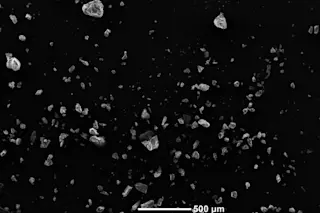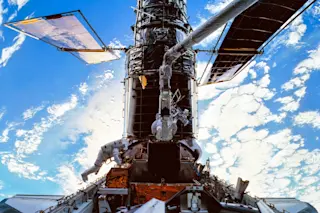At first it looked like a year of promise for a space agency still reeling from the Columbia disaster. On January 2 Stardust zoomed within the gassy and dusty halo of comet Wild 2. The next day the rover Spirit touched down flawlessly on Mars, followed later that month by Opportunity. After that, nothing seemed to go right.
Space Shuttle Program—The shuttles have been grounded for 23 months, since Columbia disintegrated February 1, 2003. Crews are addressing 28 recommendations by an accident investigation board. These include modifying the shuttle’s external tank to prevent the loss of foam insulation during launch and giving astronauts the ability to detect—and repair—damage to heat-resistant tiles while in orbit. But the program couldn’t get a break from the weather. A pounding season of hurricanes in Florida forced shuttle managers to push back the launch of a revamped Discovery to no earlier than May.
International Space Station—With NASA’s shuttle fleet grounded, the International Space Station is beginning to show signs of disrepair. In September the station’s main oxygen generator failed again, but it was restored to a “nominal configuration” a month later, says Mark Geyer of the Johnson Space Center. The Control Moment Gyro, which helps maintain the station’s position in space, needs to be replaced but is too large to be ferried up in Russia’s Progress supply ship. Meanwhile, the station’s storage space is reaching capacity. Normally, the shuttle would cart off trash, docking devices, and other large items in need of renovation. Progress can remove the routine day-to-day garbage—although in September some antenna covers and other junk were simply jettisoned into space—but its cargo bay is not big enough for hardware. The gyro will be hauled away on the next shuttle flight.
Hubble—The space telescope was given a death sentence, then a reprieve. In January NASA administrator Sean O’Keefe surprised astronomers by canceling the next servicing mission, set for mid-2006. The telescope, which recently lost one of its four main instruments, the imaging spectrometer, could fail as early as 2007 without new batteries. By then it will have lost a key gyroscope needed to keep it stable.
The death sentence put O’Keefe under pressure from scientists and politicians. In June he backtracked and ordered development of a robotic mission to perform maintenance and install new scientific instruments. NASA requested $300 million in emergency funding from Congress for a December 2007 mission. Robots can do the same job as astronauts, says program manager Preston Burch. While they move more slowly than humans, Burch says, there are no limits to how long they can operate in space.
Genesis—Mission planners expected Genesis to return to Earth on September 8 after 2 1/2 years of trapping billions and billions of charged oxygen, nitrogen, and other ions in the solar wind. They predicted the catch would resemble the interstellar gas and dust from which the sun and planets originated. Instead, the $264 million probe tumbled splat into the Utah desert after its parachutes failed to deploy (a gravity switch device had been installed backward). NASA’s scientists spent weeks recovering, cleaning, and cataloging the contents of sample containers and were surprised to find that much of Genesis’s payload survived. “I believe we will meet our top four science objectives, although experiments that require large intact areas of collector material may be in jeopardy because we are facing a lot of breakage,” says lead scientist Don Burnett of Caltech. Although preliminary results may be released this summer, he says: “We might not have a final reckoning until 2008. This is a slow process.”














